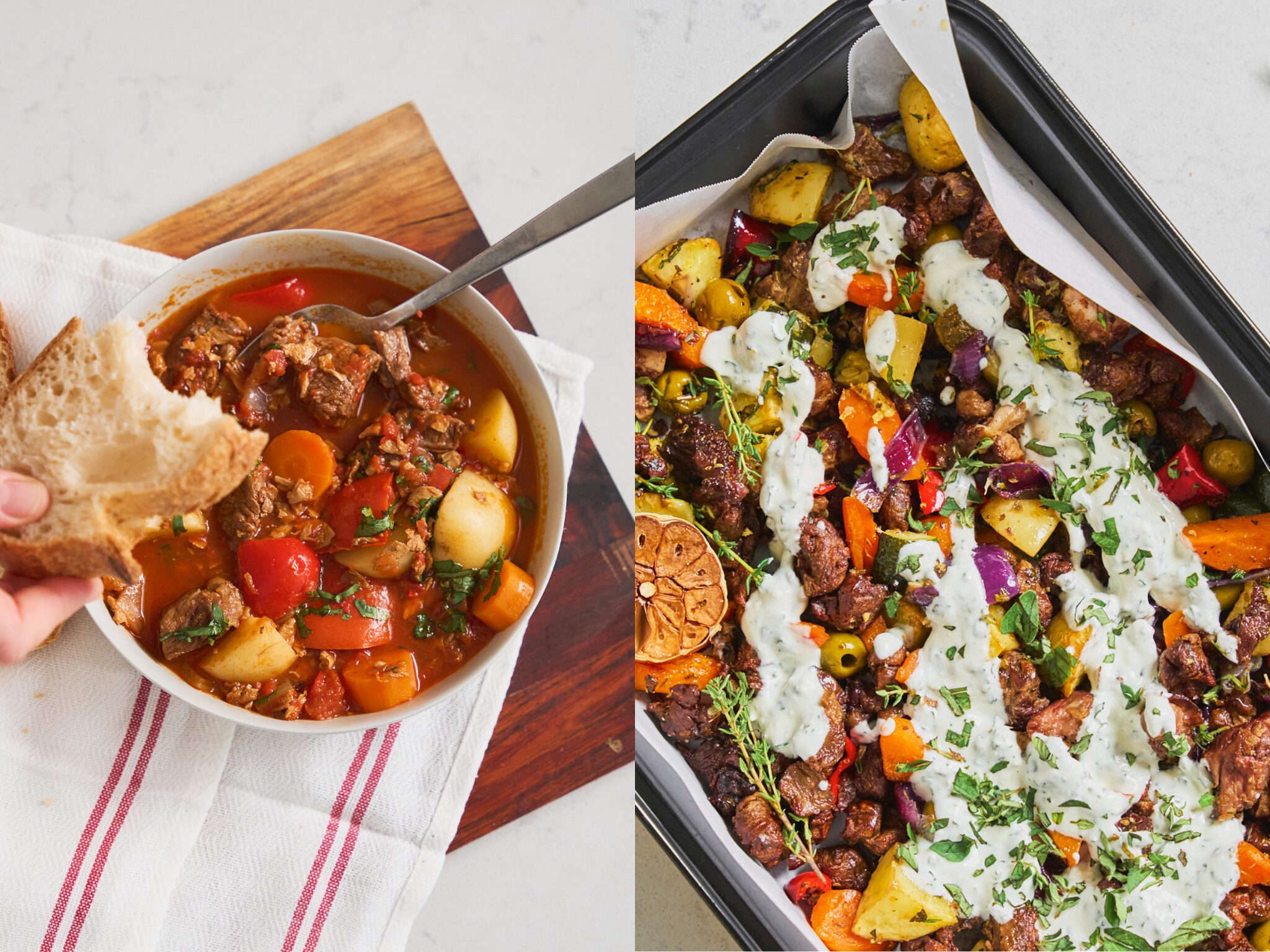Exclusive: Australia’s Harvest B Unveils Blended Meat Range Ahead of US Expansion & Series A
8 Mins Read
Australian alternative protein startup Harvest B is entering the blended meat space with 50/50 slow-cooked beef and lamb SKUs, as it prepares for a US expansion and its Series A funding round.
Known for its range of plant proteins, boosters and meal solutions, Harvest B has launched a new line of Complementary Proteins that blend animal proteins with plant-based ingredients.
The slow-cooked beef and lamb mark the New South Wales-based company’s first foray into blended meat, and come after closing its latest seed funding round, which takes total investment in the company to $4.7M. The diced meat products are geared towards the foodservice industry, and bring several environmental, health and cost advantages over conventional meat, while retaining its flavour and texture.
“As we began supplying our products to customers, we realised many were blending our high-performing proteins with animal proteins purely for cost savings,” Harvest B CEO Kristi Riordan, who co-founded the company with COO Alfred Lo in 2020, tells Green Queen.
“Meanwhile, we learned that another group of customers had been trying to scale plant proteins for sustainability, but were facing consumer acceptability challenges,” she adds. “Unlike the customers led by cost, this cohort was motivated by emission reductions and found that blended solutions offered greater consumer acceptance, while also delivering cost savings and nutritional benefits.”
Cheaper, better for you and less polluting
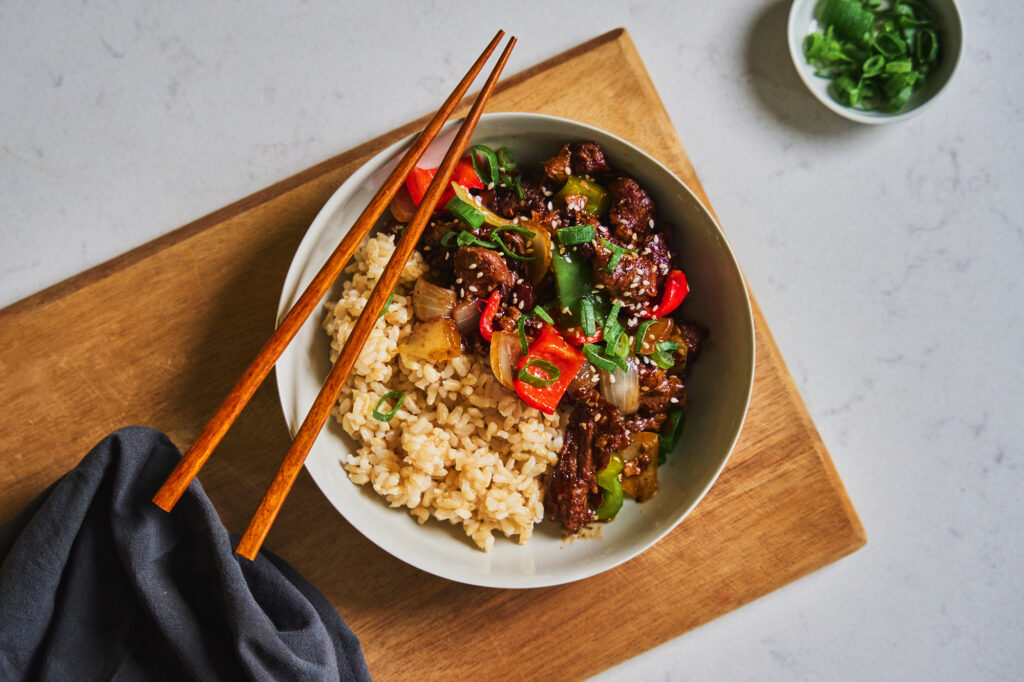
Blended meat is a nascent market, but is gradually gaining steam. Riordan explains that while plant proteins have been “used for decades” in meat products to reduce costs – McNuggets being a prime example – the current first-generation blended meat products rely on binders or casings in the finished product.
Harvest B’s innovation represents the next generation, with a patent-pending tech that combines different plant protein structures in a unique way to enable the creation of whole pieces like diced beef or lamb with an enhanced texture and without additional ingredients or processing. “Our red meat products are an effective mimic for the structure of slow-cooked beef, lamb or other animal proteins,” says Daniel Mullette, the company’s R&D director.
“This technology underpins Harvest B’s ability to combine whole pieces of raw beef, or lamb, with plant proteins. Furthermore, through the slow cooking process the consistency and texture of the plant proteins complement the animal proteins so well that they are indistinguishable in many dishes,” he adds.
The slow-cooked meats have a 50/50 ratio of beef or lamb with a soy and wheat protein blend, and nothing else, which increases their versatility in foodservice applications. The products absorb what’s called the purge, or the high-protein that’s left behind in meat packaging or the pan. This means less waste, less packaging, and lower transportation costs.
Compared to their conventional counterparts, Harvest B’s blended meats deliver 30% more yield for the same cost, with half the cholesterol, 45% less saturated fat, and 30% less packaging needed. The inclusion of plant proteins also means they have fibre, while retaining their iron and vitamin B12 content. In terms of the climate, the products reduce emissions from animal-derived meats by 46%. And they boast 23-24g of protein per 100g.
Overcoming blended meat’s acceptance challenges
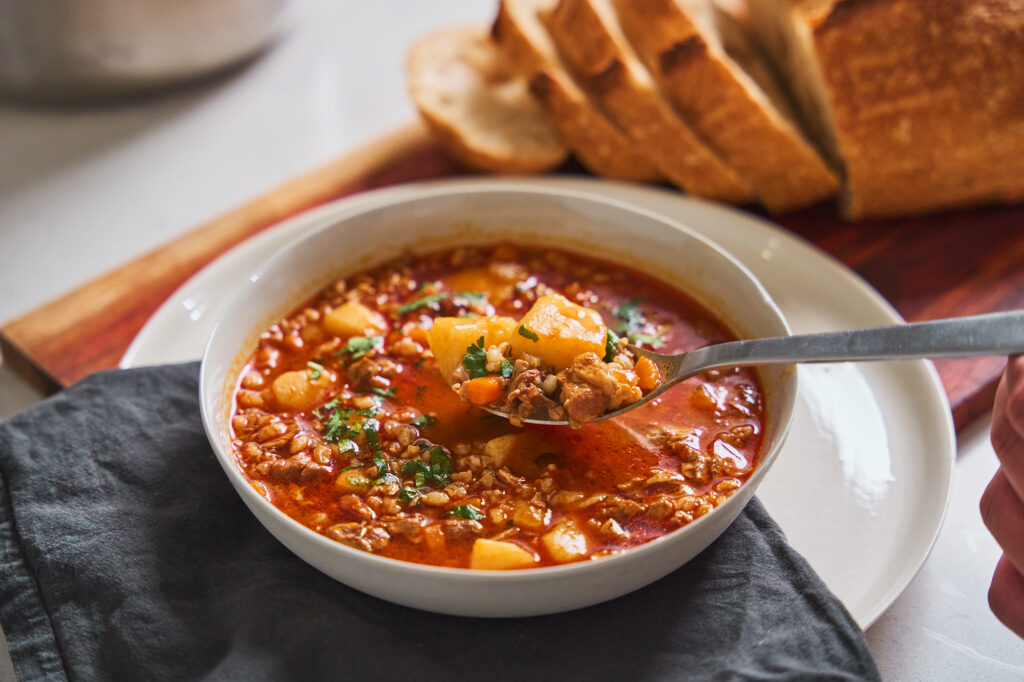
The blended meat category can tend to be a very tricky space. Retailers like Aldi and meat giants such as Tyson Foods have previously brought blends to the market, but they were discontinued quickly after failing to capture consumers’ grocery carts.
Some have blamed Tyson’s marketing for its blended meat debacle. Andrew Arentowicz, founder and CEO of US-based 50/50 Foods, told Green Queen last year: “Tyson’s Raised & Rooted blended burger said they were ‘beef and pea protein isolate’ burgers. Who wants to eat – let alone buy – pea protein isolate?”
Mullette echoes this sentiment: “All food products need to deliver a strong value proposition with marketing that authentically connects that to the consumer.” While taste is “always table stakes with food”, there needs to be more that the consumer cares about and sets the product apart. and it’s not sustainability – which blended meat producers have painted as their primary USP. “Truth be told, mainstream consumers don’t want to sacrifice or pay for sustainability. Many mainstream consumers don’t even want to know that there are plants in their food,” he states.
“Meat-eaters already consume a huge amount of plant protein – most brands just don’t focus on this in their marketing,” says Mullette. Harvest B conducted a recent audit of the Australian market, finding that the actual animal meat content in bestselling retail products “would surprise many consumers”. Chicken tenders, for example, comprise just 38-52% meat, beef burgers 67-85%, meatballs 70-84%; and sausage rolls a meagre 18-25%.
“Harvest B believes that achieving taste, in a familiar format, at a more affordable price with better nutritionals gives a compelling reason to buy. Meanwhile, a more sustainable protein is simply the benefit,” he says. “By working with a wide variety of market segments, we anticipate different approaches to marketing depending on the value proposition important to the brand, or venue.”
Tyson’s blended meat failure also came on the retail shelves, which is why taking the foodservice route makes sense for Harvest B. Riordan believes this is an untapped opportunity, given institutional foodservice often has a regulated requirement for protein, cost-per-serve constraints, and a desire to reduce emissions.
“One of Harvest B’s customers told us that we are the only supplier that can improve nutrition while also reducing costs and emissions,” reveals Riordan. “We are also excited to work closely with executive chefs to strategically build Harvest B’s protein portfolio to address the problems they face on a daily basis.”
Its diced beef and lamb are cooked via sous vide before being frozen, and delivered to chefs who can pan-fry, oven-roast or braise the meats, and use them in dishes like curries, stir-fries, salads and soups, among others. They have a 12-month shelf life too, which will appeal to foodservice settings “where convenience and avoidance of food waste are paramount”.
Blended meat approved by chefs and legacy protein producers
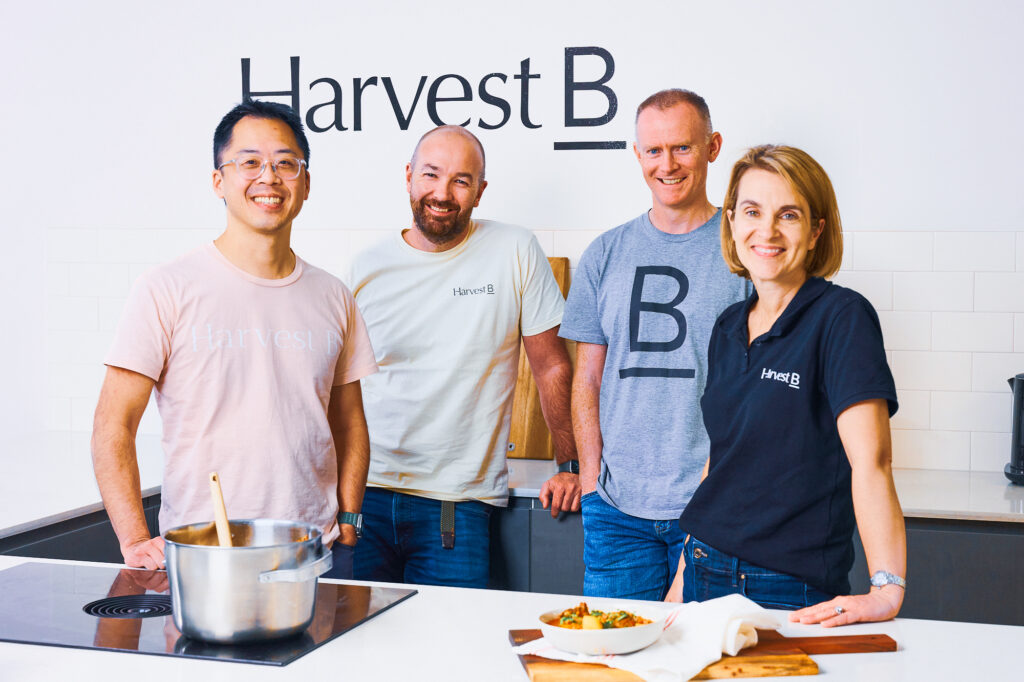
Harvest B’s blended meat products will appeal to the 19% of Australians who identify as flexitarians, according to a YouGov poll last year. A separate study additionally suggested that 32% of the country’s population reduced its meat consumption in 2023. The success of blended meat products will rely upon taste more than anything else, with 59% of meat-eaters and 42% of flexitarians calling this the most influential driver of food choices.
To address that, the startup has developed its blended meat range in partnership with animal protein producers, which will also help bring the products to market globally. “Sensory tests were conducted with internal stakeholders at these partners to ensure we were able to achieve a profile that met the expectations of traditional animal protein consumers,” says Riordan.
She adds that the products can be used in institutional foodservice spanning airlines, education, defence, mining, aged care, and hospital sectors: “We have conducted trials with executive chefs and nutritionists across each of these segments who are excited by the taste and texture, as much as they are by the nutritional benefits we can deliver.”
The concept has been proven elsewhere. 50/50 Foods has landed its half-beef, half-plant Both Burger on a Disneyland menu, while Mush Foods’s 50Cut is featured in leading butchery Pat LaFrieda’s new blended burger for foodservice. And it’s not just blended meat that’s making waves, hybrid meats – which combine cultivated meat with plant-based ingredients – are also appearing on the horizon. San Francisco-based startup SciFi Foods, for instance, is aiming to receive regulatory approval for its hybrid beef burgers and enter foodservice by early 2025.
Cultivated meat was in Australian headlines last week after Vow became just the fourth company in the world to obtain the regulatory greenlight for cultivated meat, rolling out its cultivated quail as part of a parfait in select restaurants in Singapore.
“A complementary system works best when taste and value are beneficial to a customer and consumer – creating a driver for systemic behavioural change which, in turn, drives adoption of sustainable practice,” says Mullette. “This is the intent behind Harvest B’s Complementary Proteins; a similar approach could easily be adopted with complementary food products formed from blending plant-based and cultivated proteins.
“If the flavour, texture and value of protein products can be advanced by blending plant-based with cultivated meats, then an advantageous driver exists for its adoption as part of a complete, nutritious global food system.”
Harvest B plans Series A for US expansion
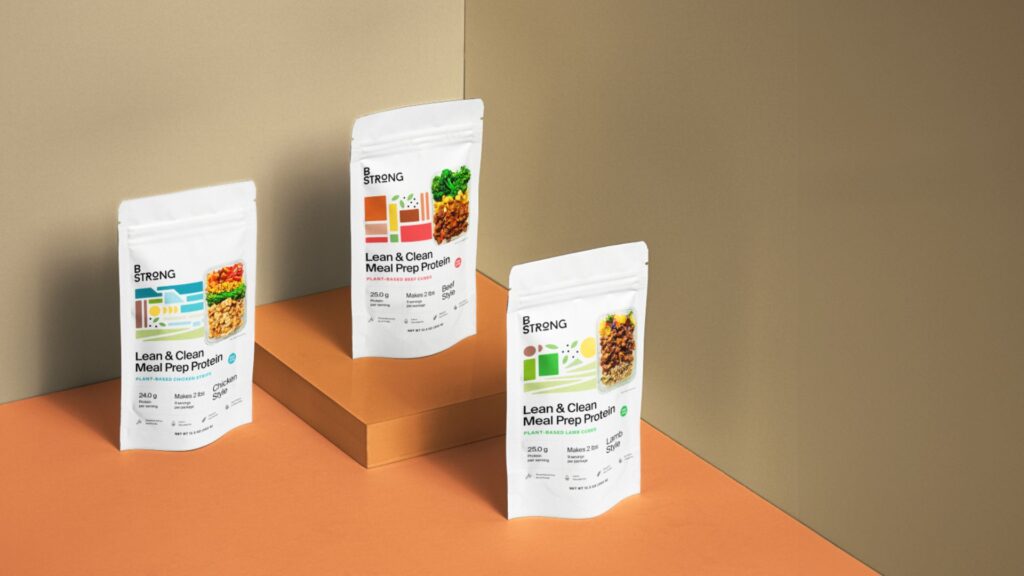
The progress made by companies like Vow and Harvest B signposts the next phase of growth for Australia’s alternative protein sector, which includes product and tech innovation as much as marketing, says Riordan.
“The category was primarily built by idealists who raised awareness of the emissions problem in our food system. However, this also created a strong division between those who eat meat and those who do not with challenges to drive further mainstream adoption,” she explains, noting how Australia’s national science organisation CSIRO rebranded its research portfolio from ‘alt-protein’ to ‘complementary proteins’ last year. It was “a nod to thinking differently about the product, tech and marketing of our future protein system”.
Harvest B has used the latest capital injection to drive its R&D roadmap further, build its pilot facility, and amp up sales and marketing. “We have received support from the Australian Federal Government via the Advanced Manufacturing Growth Centre to stand up our manufacturing capabilities,” says Riordan.
The company recently launched its consumer brand, B Strong, into the North American market. The products are focused on meal prep solutions for fitness-oriented consumers, and are available on e-commerce marketplaces like Kroger, Walmart and Amazon.
“B2B remains the immediate focus for Harvest B, particularly in the foodservice and high growth ready meal segments,” Riordan states, revealing that the company will now look to raise a Series A funding round to support its B2B expansion in the US. Slated for the upcoming financial year, the blended meat producer is targeting a sum of around $7M.
But this period will also see substantive Australian federal funding programmes become available to local food manufacturers. Harvest B will tap into these programmes to complement its raise, meaning its Series A sum may not need to be as large.
“We remain bullish about the opportunities the market has to offer,” says Riordan. “Classic innovation theory shows time and again that crossing the chasm from early adopters to the mainstream requires a step change. From a pragmatic view, we need more work on product-market fit and the value propositions of affordability and health – especially for market segments where high protein is required.”
She continues: “We believe that improved sustainability will follow solving those problems. And we believe that plants can enable high quality, affordable protein for meals designed for the way people like to eat – whether vegan, vegetarian or meat eaters.”

